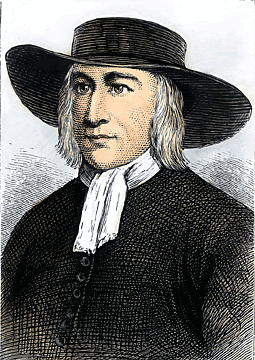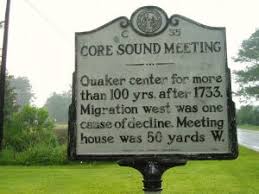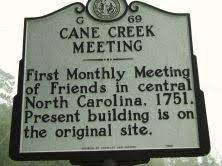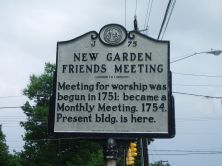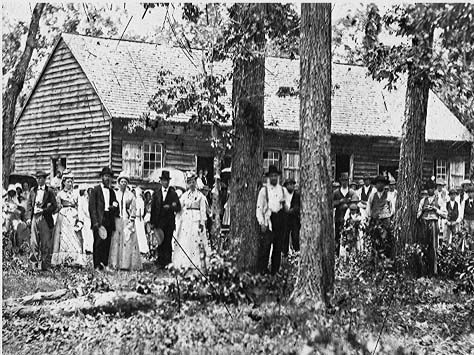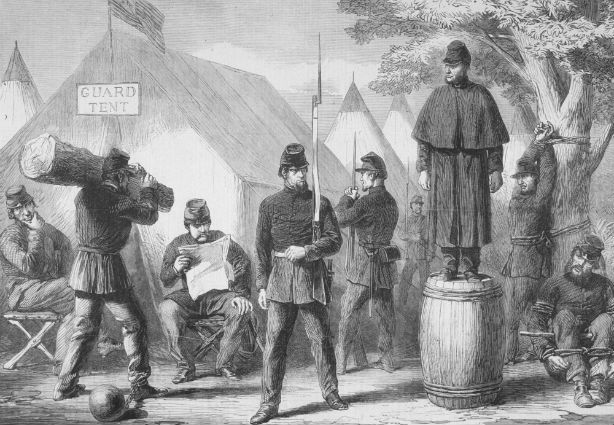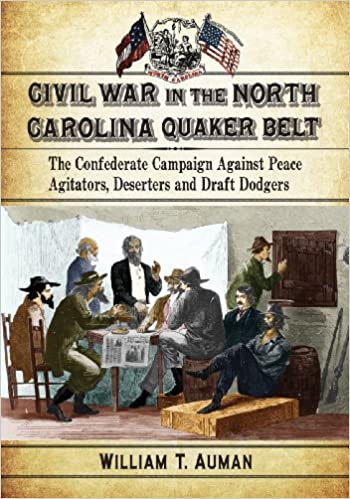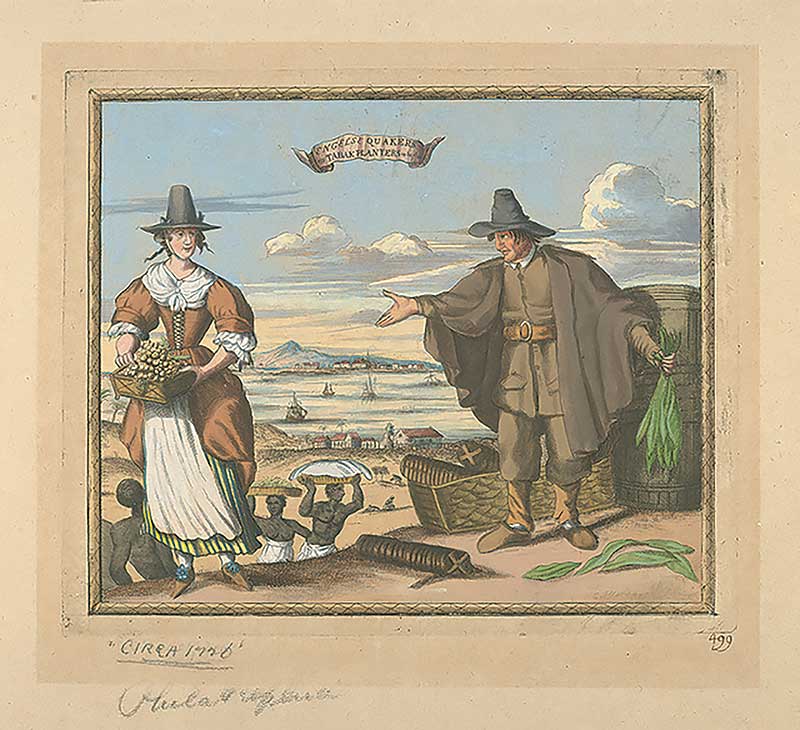
One of the most common questions I get asked is, Why was Randolph County so different from most of the rest of North Carolina? The short answer is, Quakers. The Religious Society of Friends, commonly known as Quakers, were not the most numerous religious group in Randolph and Guilford counties, but they were by far the most influential in setting the social and behavioral norms of Randolph County and central North Carolina from the 1750s to the 1850s.
From the time it was established by Henry VIII in 1534, membership in the Church of England was required of anyone holding public office. All other religions were illegal, and “dissenters” were persecuted and punished. The largest group of these were the Puritans, followers of John Calvin, who became the dominant religious group in New England. George Fox (1624-1691), considered the founder of the Religious Society of Friends, was born in a strongly Puritan village in Leicestershire, England, but rebelled against the Puritan government instituted after the English Civil War. Critics claimed his followers “quaked” or shook with religious excitement when they spoke, and “Quaker” became their common name. Fox travelled throughout Britain as a dissenting preacher, and was arrested and jailed numerous times for his beliefs. The lack of tolerance for dissenters in England caused Quakers to move to America, particularly to Rhode Island, Pennsylvania and North Carolina, all of which permitted religious freedom for Christians. Fox visited the Chowan River settlements in the Albemarle region in 1671, and preached the first worship services in the colony. The North Carolina Yearly Meeting was established in Perquimans County in 1698, and the first school in North Carolina was established by the Quakers of Pasquotank County in 1705. John Archdale, Governor of the colony of North Carolina from 1694-96, was a member of the Society, but by the 1760s being too involved with the politics of “the World” was no longer considered proper by Quakers.
Fox organized the Society of Friends on a mystical principle, that direct experience of God was possible if people “waited on the Lord” to speak to them. Perhaps the most important belief that distinguished Fox and his followers from other Christians was that this “Inner Light” was a characteristic of all human souls, male, female, yellow, brown, black, or white.This meant that all human beings were already part of God, so there was no belief in damnation, nor any need for salvation. A portion of the Holy Spirit, the Inner Light helped people distinguish good from evil, speaking directly to the conscience. With a part of God in every soul, all people were literally connected, and harm to anyone was harm to oneself. This led to the Quaker belief in pacifism, and their opposition to human slavery. This also meant that Quakers held “meetings,” and did not need “hireling ministers,” churches or “steeple houses,” and that women as well as men could lead their groups in silent prayer or meditation.
Similar to modern Sikhs in their turbans, early Quakers could be recognized as such by their distinctive modes of dress and speech. These also arose from the fact that the Inner Light was in everyone; therefore no person was better than anyone else. A concern with outward appearances or valuing material objects indicated that a person valued worldly rewards over those of the spirit. Plain clothing was such a symbol of Quaker beliefs, as it was a sign of pride to wear flashy dress or jewelry. Similarly, “plain speech” indicated that Friends did not believe in rank or titles. In 17th century English, the second-person-singular used “thee” and “thou,” as demonstrated by the Kind James translation of the Bible. The British upper-class, however, expected to be referred to with the second-person-plural “You,” an indication of greater respect. Quakers insisted on referring to everyone as equals, and were often made fun of by their continued use of “thee” and “thou” even as English grammar gradually changed. Quakers also refused to show “hat honor,” by removing their hats as a sign of respect to “their betters.” Finally, Quakers refused to swear oaths, as the Inner Light in everyone meant that God was already present, and didn’t need to be called upon to verify the truth of what was said. One of the earliest changes to the North Carolina state constitution of 1776 allowed Quakers to affirm rather than swearing an oath, and is still the law today.
Quakers first began to settle in central North Carolina in the 1740s, and the first meeting, Cane Creek, now in Alamance County, was founded in 1751, with the second, New Garden in Guilford County, founded in 1754. Herman Husband, a Quaker, came from Maryland and settled near what is now Liberty in the 1750s, and his relatives the Coxes and Allens began to settle the Mill Creek area about the same time. Friends met in private homes for many years, with the Western Quarterly meeting in 1760 allowing Cane Creek to sponsor “friends on Deep River adjoining… William Cox… to have a meeting of worship settled among them.” In 1787 the Mill Creek congregation accepted a deed of 50 acres “for the use by the Society of the people called Quakers;” and Holly Spring became an independent Monthly Meeting in 1818. Meetings began in the Polecat Creek/ Providence area in 1762, with a “little meeting near Benjamin Beeson’s.” A meeting house was built there in 1769, but Monthly Meeting status was only granted in 1792. Meetings also began in the Back Creek area in the 1760s. Thomas Winslow deeded the trustees 26 acres of land in 1785; the Preparatory Meeting was established in 1786. It became an independent Monthly Meeting in 1792, the first meeting in what became the Southern Quarterly Meeting.
At one time Randolph County had at least 16 active Friends meetings, the most of any county in North Carolina. But strict adherence to Quaker beliefs was difficult when surrounded by as many different immigrant sects and beliefs as were found on the southern frontier. Friends could be disciplined for dressing or speaking “contrary to discipline,” or for “marrying outside of unity.” The most severe penalty was being disowned from membership. Service in the military was forbidden, which created a real problem in a society such as North Carolina which was organized on the basis compulsory white male militia service. Tax listing, voting, petitions for new roads, bridges and services were all done at quarterly militia meetings, and Quakers who refused to participate gradually lost their voice in political affairs. But their moral influence in the county remained extensive. For example, even when capital punishment was common and expected during the 19th century, Randolph County sheriffs refused to execute convicted prisoners here, sending them instead to adjoining counties. Randolph is also the only county in central North Carolina where there is no recorded example of a Negro being lynched, or of any Ku Klux Klan murders. While Randolph was by no means a haven for African-Americans before 1865, neither did it countenance the hellish mistreatment of an Alamance County, or the Deep South states.
While the Revolutionary War was certainly a trial for Quaker beliefs, the period after the war saw the issue of slavery come to the forefront. The North Carolina Yearly Meeting on November 23, 1787, adopted and presented a petition to the state legislature which called “for the emancipation of the Slaves, the property of the people called Quakers, under certain rules and restrictions.” [ State Records of NC, XX, 144]. Unfortunately, rather than easing restrictions on freeing the enslaved, the state gradually increased them to the point of prohibition. By 1800 many Quakers were choosing to leave North Carolina for the newly created free states in the Northwest Territory (Ohio, Indiana, Illinois), where none of them had to worry about the scourge of chattel slavery. For a time citizens of Randolph and Guilford supported the Manumission and Colonization Society, which promoted the gradual emancipation of slaves and their return to Africa. Not only Quakers but many Randolph County slaveholders supported this idea, which eventually resulted in the creation of the new African country of Liberia. Randolph County had an usually large percentage of “free people of color,” slaves freed before changes in North Carolina law made that impossible. North Carolina law gradually began to force even Quakers to comply with laws that required them to assist in capturing escaped slaves. Out of this conundrum- how could Friends comply with the laws of man when they conflict with the leadings of the Holy Spirit?- grew the Underground Railroad.
There are virtually no written records documenting private anti-slavery activities. It is clear that many of the leaders of this movement in North Carolina were Quakers, specifically those descended from the 1771 Quaker emigrants to New Garden from the island of Nantucket. Levi Coffin, “the Reputed President of the Underground Railroad,” wrote in his autobiography of working with his Uncle Bethuel and cousin Elisha Coffin in smuggling an escaped slave to Ohio in 1821. (Elisha was then a prominent landowner and mill developer in Randolph County, and later founded several early cotton mills with other Quaker investors.) Joseph Newlin, operator of the toll house at the New Market Inn, is also known to have assisted travellers on the ‘underground road’ both before and during the Civil War.
During the war Friends were again subject to the universal military service requirements of the Confederacy. At first they were allowed to pay for a substitute, but some friends refused to participate in the war even to that extent. As the war dragged on, the conscription laws forced Quaker men into the army. Men who refused to fight or even carry a gun were tortured, and sometimes executed. Some deserted, or hid in the woods from the enrolling officers. An Account of the Sufferings of Friends of North Carolina Yearly Meeting, in Support of their Testimony Against War, from 1861 to 1865 (Peace Association of Friends in America, 1868) and Fernando G Cartland’s Southern Heroes or The Friends in War Time (London, 1897) contain the most evocative accounts of Randolph County Quakers during this period. After the war Northern Friends were so concerned about the destitution of their brethren in North Carolina that they established special missions and schools to support local Quakers. The Springfield Model Farm north of Archdale, and Evergreen Academy near Holly Spring were both established by the Baltimore Association.
The war damaged or weakened almost all of the traditional Quaker “testimonies”: Peace, Simplicity, Integrity, Community and Equality, and the western exodus of Friends continued and even accelerated. In the 1870s many meetings began to hire preachers, and to adopt an order of service similar to every other Protestant denomination. This caused a schism that resulted in 1906 in the formation of the North Carolina Yearly Meeting (Conservative), a group that retained the tradition of silent worship. While there were some Conscientious Objectors during World Wars I and II who followed the Peace Testimony, it was never again the moral imperative it had been during the Civil War. More and more southern Friends adopted the attitudes and political leanings of their neighbors. Tensions arose over fundamentalist theology, the Civil Rights movement, homosexuality, women in pastoral leadership, and commitment to the Peace Testimony. Fundamental disagreements with traditional Quaker thought were expressed to the Yearly Meeting by Poplar Ridge Meeting in Trinity in 2014, and subsequently joined by more than a dozen other meetings. In 2017 the divergence of North Carolina Friends from traditional Quaker testimonies was so stark that the 300-year old Yearly Meeting divided into two separate organizations, the North Carolina Friends Fellowship and the Friends Church of North Carolina, subscribing to an evangelical theology which attracted most of Randolph County’s former meetings.
[For a more thorough treatment of the history of Friends in North Carolina, see Max L. Carter, “Quakers,” in W. Glenn Jonas, Jr., ed., Religious Traditions of North Carolina (McFarland & Co., 2018), 248-265.]
